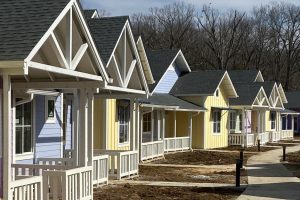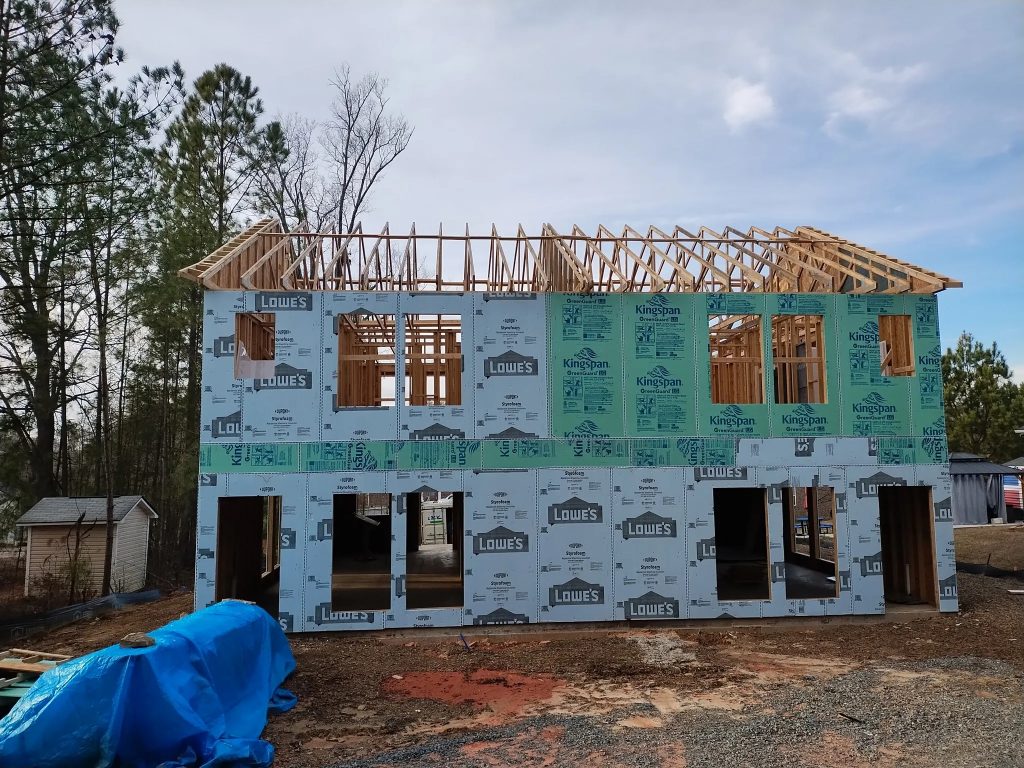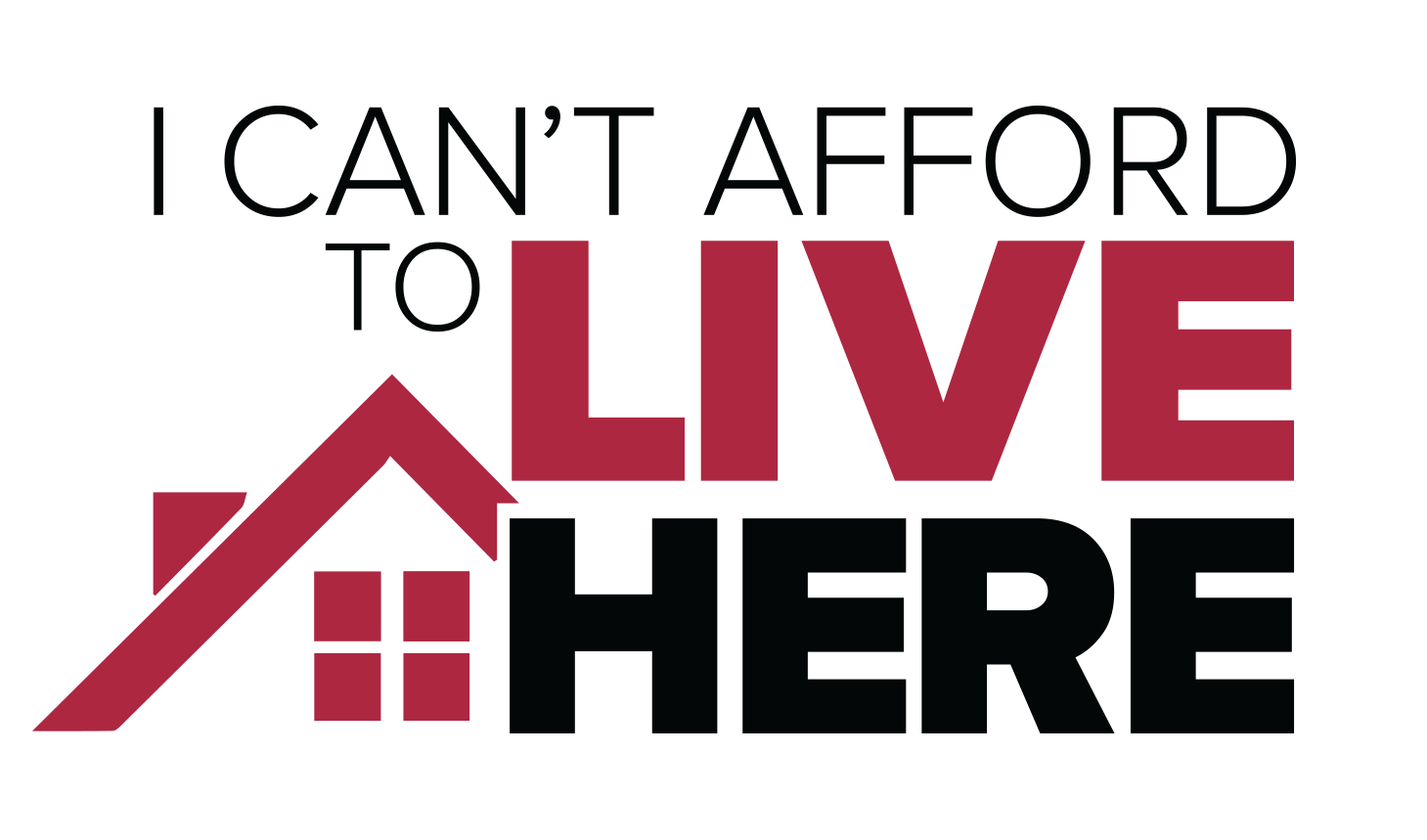
Cohousing with a community of LGBTQ seniors provides for a unique way to live in place. (Photo Credit: Village Hearth Cohousing)
Chris Rudisill
March 20, 2020
In a series of investigative stories, qnotes is examining solutions around the country that could positively impact affordable housing opportunities in Charlotte, with the specific interests of LGBTQ people in mind.
 One such concept is cohousing, defined as “community designed to foster connection” by the Cohousing Association of the United States. These communities often feature common grounds where neighbors can easily interact with each other and shared spaces like kitchens, dining spaces and gardens where residents, while living in private homes, can create collaborative living and management of their own communities. Somewhat surprisingly, the first and only LGBTQ cohousing community in the country, Village Hearth Cohousing (VHC) is located at the back of the Eno Trace neighborhood of Durham, N.C. just 15 minutes from Duke University and Downtown. The community, which will be completed this spring, does not qualify as affordable housing in most scenarios with prices ranging from $299,000 to $409,000, but there are striking factors in the concept that could easily be adapted to communities of any economic demographic. Kathryn McCamant, founder of CoHousing Solutions, often talks about the environment and social sustainability that can be appealing to communities exploring the idea. “That’s what is really exciting about the cohousing concept is you can adapt it to these very different situations,” says McCamant.
One such concept is cohousing, defined as “community designed to foster connection” by the Cohousing Association of the United States. These communities often feature common grounds where neighbors can easily interact with each other and shared spaces like kitchens, dining spaces and gardens where residents, while living in private homes, can create collaborative living and management of their own communities. Somewhat surprisingly, the first and only LGBTQ cohousing community in the country, Village Hearth Cohousing (VHC) is located at the back of the Eno Trace neighborhood of Durham, N.C. just 15 minutes from Duke University and Downtown. The community, which will be completed this spring, does not qualify as affordable housing in most scenarios with prices ranging from $299,000 to $409,000, but there are striking factors in the concept that could easily be adapted to communities of any economic demographic. Kathryn McCamant, founder of CoHousing Solutions, often talks about the environment and social sustainability that can be appealing to communities exploring the idea. “That’s what is really exciting about the cohousing concept is you can adapt it to these very different situations,” says McCamant.
For Margaret Roesch and Pat McAuley, who moved to Durham in the early 1990s, the idea for VHC came from a beach trip where they would regularly share a large house with other friends. Roesch remembers them saying excitedly “We should do this when we retire — we could all have a big house.” As they began to talk about their dream, they soon realized that any concept of a shared house was a little too much and too close. They searched for solutions and found a regional conference in Boulder, Colo. that was showcasing the cohousing concept in 2014. As LGBTQ older adults, they wanted to make sure they could age in place and in a space where they could be themselves. “Being proactive so that we can make our own decisions rather than someone making a decision for us in a crisis — that’s really what this was about,” says McAuley.
LGBTQ older adults face many additional challenges in finding supportive, or even safe, housing. Services and Advocacy for LGBTQ Elders (SAGE), reports that many LGBTQ older adults “face harassment and intimidation in their homes or in long-term care settings from aging professionals, other residents, and even their own family members.” Forty-eight percent of older, same-sex couples have experienced housing discrimination, according to the organization’s research. Safe and affordable housing is one of the biggest issues facing the community today.
McAuley and Roesch enlisted the help of cohousing experts McCamant and Charles Durrett, who introduced the concept to the U.S. in 1988 after extensive study in Denmark. The idea was to create 28 homes on 15 acres, with a 2,600-square foot Common House. According to their brochure, VHC will include “an amazing group of people who bring a vast array of interests, talents and experiences to share.” Roesch and McAuley personally invested in the property in Eno Trace in August 2015, after looking at over 275 real estate listings. Many cohousing projects across the country get launched, but take years to develop or never come to fruition. There are currently over 200 projects in the United States. One thing they did differently from other groups was to get the land first. It took six months. “Just go with it,” McCamant told them. “You’re building this community on this land. Who wants to come with you?”
I met some of the future residents recently in Durham to find out why the concept was appealing to them.
Linda Hobbet joined the project on the same day Roesch and McAuley found the property. She lived in Athens, Ga. prior to moving to Durham and had previously heard of cohousing. “I joined the project pretty early,” she says. “The whole idea of knowing your neighbors and being mutually supportive was appealing.” As a single person, she’s a self-identified introvert — something that is common among many of VHC’s future residents. “It’s actually really good for introverts,” she says. “In cohousing, you get to know each other rather well. Instead of cocktail party conversations, you can have deeper conversations if you want, and it’s about being able to balance community and privacy.”

Allan Keech is a proud resident of the community. He and his partner joined the project in 2015. (Photo Credit: Village Hearth Cohousing)
Rev. Christopher Ross and his partner, Allan Keech, also joined the project in 2015 when it was just an idea. During my visit, I toured their new home. Ross wrote about the community in “Home is Where the Hearth Is” in qnotes earlier this year. “It was not something we set out to do,” says Ross. Both Ross and Keech also identify as introverts. After leaving New York, they bought a 58-acre property in rural Virginia. “It was a romantic notion,” remembers Ross, but he couldn’t stand the isolation. They would often drive 120-miles round trip to Durham for social connection or needed services. Nature was important for Allan, and Christopher wanted more social interaction. “This was a good compromise for us,” says Ross. In a recent article, he refers to Dona McNeil, another member of VHC who “commented that while our front doors are a mere 40 feet apart, cohousing is not about being in each other’s faces. It’s about having each other’s backs.”
“I lived in, I don’t know how many, different neighborhoods in New York, brownstones that were carved up into apartments and high-rises,” says Ross. “You could walk out of your door into the hallway and there would be a door right across the hallway from you and never know who lives there.”
It’s Not a Commune
After the Vietnam war, groups of Americans moved away from cities to form communes or communal-type farms, including lesbians who were disenchanted by both the emerging women’s liberation and gay rights movements. Groups like the Hawk Hill Community Land Trust and “Womyn’s land” created closed-off communities that had their own support and hierarchical structures and were women-centered. Male-centered groups like the Radical Faeries formed “sanctuaries” in places like Short Mountain, Tenn. which remains home to the oldest planned community for LGBTQ people in the country.
“I was thinking more of a commune kind of thing,” says Tami Ike remembering when she first learned of Village Hearth Cohousing. Ike and her partner, Patricia, are originally from Greensboro and joined the group in 2017. “I got a better feel for what cohousing was,” says Ike. Cohousing is often confused with the concept of communal living. In a commune, residents jointly own the land and all resources, while cohousing involves owning private homes and creating intentional community through planning and management. Cohousing communities, like VHC, operate in the concept of a sociocracy, or set of tools and principles that ensure shared power — not necessarily shared ownership.
“Many people just need a little bit of help from time to time,” says co-founder Roesch. Being in a wheelchair, Roesch can’t drive and believes she would be in an assisted living facility if it wasn’t for the support system around her.
Jane Parrish signed on in 2018, moving to Durham from Hudson Valley, N.Y. “I kept coming across these condos that were like three-story buildings and 3,000 residents, and I was getting more freaked out by the moment,” says Parrish. “I can’t do that — it’s just so anonymous.” She was completely unaware of cohousing at the time when she came across VHC. “The minute I saw it, I knew it was exactly what I wanted. It was community-based. It would be supportive. It was in a great area. It would give me a purpose.”
McAuley calls it an “intentionality of the community” to help and care for each other. “To live in community, you need to value what you gain by collaborating with others. It requires the ability for give-and-take and a willingness to seek the best solution for the community as whole, not just one person’s brilliant idea,” said McCamant in the documentary film “The Best of Both Worlds, Cohousing’s Promise.”
Eleanor Anasar, another future resident of VHC was originally from Montréal, Quebec in Canada and moved to Durham from Los Angeles, Calif. to join the project in 2018. “I knew I needed community,” says Anasar. After losing a partner who had long-term Alzheimer’s disease, she was seeking out cohousing but wasn’t sure that a project in Durham would work for her. “Obviously, I had my concerns. It’s just a great place to live. I found the community that I really love,” says Anasar.
A Model to Explore

Residents of the community gather onsite during the building process. (Photo Credit: Village Hearth Cohousing)
From shared resources to safety and support, the concepts of cohousing can be promising for LGBTQ older adults in cities like Charlotte. McAuley talks about how the model can involve a focus on affordable housing as well. “It needs to be intentional from the beginning,” she says. At Rocky Corner Cohousing in Bethany, Conn., a select number of homes were set up to be sold at subsidized prices for households earning at or below 60 percent of the area median income.
A group in Santa Fe, N.M. got free land through land trusts which helped keep their overall development costs down. Petaluma Avenue Homes in Sebastapol, Calif. used low-income housing tax credits and city and county funding to create affordable rental units based on a cohousing model. VHC has had inquiries into their model from as far away as Australia, including another project in North Carolina that will focus on lesbians of color.
A major economic benefit of cohousing communities is shared resources. Village Hearth residents will share tools, large kitchen supplies and meals. A guest room in the Common House will provide space for visitors when needed. “The purpose is to live small,” says Keech. “The community is more important than this trinket or that trinket.” Properties range from 650 square feet to 1,150 square feet. The community was also able to bundle some utilities like cable, water, trash and recycling which keeps individual costs down. The Common House also includes a community kitchen and canning area, large dining room, laundry facilities, fitness center, an arts and crafts room and a large outdoor common area.
Crystal Farmer has organized Charlotte Cohousing Community to support the development of such intentional communities around the city. According to a recent article in City Lab, University of North Carolina at Charlotte professor Robert Boyer who is working with Farmer on issues of diversity in cohousing has done research showing that the concept appeals to a wide range of demographic groups.
VHC relied on the ability of McAuley and Rausch to do the foundation work for the project, including purchasing the land. It took them 13 months working with a civil engineer and thousands of dollars to move through the zoning process. “Within that (Durham) zoning, you can’t cluster the homes,” says McAuley. “You can’t attach more than two. We need to figure that out.”
While zoning issues and costs are of major concern, the concept is gaining some momentum in communities around the area, the biggest idea behind cohousing in relation to LGBTQ older adults is creating systems of support for aging in place where they aren’t forced back into the closet or face discrimination. “This is aging in place,” says Keech. “with the intention of helping each other as we age.”



 The Charlotte Journalism Collaborative is supported by the Local Media Project, an initiative launched by the Solutions Journalism Network with support from the Knight Foundation to strengthen and reinvigorate local media ecosystems.
The Charlotte Journalism Collaborative is supported by the Local Media Project, an initiative launched by the Solutions Journalism Network with support from the Knight Foundation to strengthen and reinvigorate local media ecosystems.








